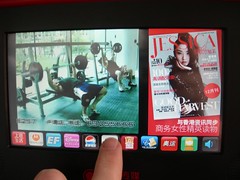 As I was reading and learning about screencasting, I found myself wondering about some things. The article “7 things you should know about Screencasting” started me thinking…
As I was reading and learning about screencasting, I found myself wondering about some things. The article “7 things you should know about Screencasting” started me thinking…
Screencasts can be thought of as podcasts of a computer monitor. Podcasts are easy-to-make audio files that can be edited and distributed online. Screencasts capture the feeling of personal connection that podcasts provide, with the added benefit of video to see what is being discussed. And, like podcasts, screencasts can be easily distributed through blogs and other Web pages.
I found myself wondering, as we’ve been discussing visual literacy, if people are taking advantage of the simplicity and versatility of screencasts. One of my favorite podcasts, Chinesepod.com, was one that I listened to while living in Shanghai to try and expand my knowledge and ability with Mandarin (which is so painfully tonal and when you are tone deaf that makes life very difficult…and unfortunately Thai has even MORE tones than Mandarin, just my luck). While trying to learn more Mandarin-well, actually when trying to learn anything-I have found that seeing words helps me tremendously. I am a visual learner; I can learn other ways, but visual cues help significantly. Even when I’m trying to learn someone’s name, writing it down or asking how it is spelled for the mental imagery helps.
 So, when trying to improve my Mandarin, I did like listening to Chinesepod.com, but I also found that having a piece of paper to write the words as I heard them helped me to retain more of the language I was learning through the podcast. I now find myself wondering if Chinesepod.com were to create screencasts in lieu of/or addition to their podcasts, if this might make the learning even more versatile for all of the auditory and visual learners out there? In my brief search, the only screencasts I found them using were in their help section with tutorials on FAQ, etc. Of course, if you pay for the subscription, you have access to more materials. My question is, if screencasts are so simple and easy to make, why aren’t those offered like the free podcasts?
So, when trying to improve my Mandarin, I did like listening to Chinesepod.com, but I also found that having a piece of paper to write the words as I heard them helped me to retain more of the language I was learning through the podcast. I now find myself wondering if Chinesepod.com were to create screencasts in lieu of/or addition to their podcasts, if this might make the learning even more versatile for all of the auditory and visual learners out there? In my brief search, the only screencasts I found them using were in their help section with tutorials on FAQ, etc. Of course, if you pay for the subscription, you have access to more materials. My question is, if screencasts are so simple and easy to make, why aren’t those offered like the free podcasts?
On a positive note, I did find in my search a Thai language learning site, Learn Thai Podcast, that did offer some free Thai language lessons and included a written transcript with each lesson. Maybe that will help my Thai language learning (not likely, remember MORE tones than Mandarin? Sigh.) I do wonder if these sites will start offering screencasts in lieu of podcasts with the plethora of video iPods and iPhones and similar devices currently in use. Sometimes I feel like I’m the only person left in the world without an iPod/iPhone!
It will be interesting to watch and see if more of the people using podcasts begin to utilize screencasts…for visual learners like me, I know I’d like to see that happen!
 In education we constantly talk about how to engage our students, how to make learning meaningful for them. This is how we do it; we provide them with that ‘competitive voice’ that David was talking about. Understanding this new digital age comes with not just understanding the connectedness of our world, but also grasping the power that each individual has to leave her mark on that same world. Utilizing visual means, we have the ability to let our voices be heard and to sell our message.
In education we constantly talk about how to engage our students, how to make learning meaningful for them. This is how we do it; we provide them with that ‘competitive voice’ that David was talking about. Understanding this new digital age comes with not just understanding the connectedness of our world, but also grasping the power that each individual has to leave her mark on that same world. Utilizing visual means, we have the ability to let our voices be heard and to sell our message. I met with a student the other day who said to me “I didn’t finish my Powerpoint presentations because I was SO confused!” He went on to explain that in one class they are working on creating presentations in Powerpoint using more of a
I met with a student the other day who said to me “I didn’t finish my Powerpoint presentations because I was SO confused!” He went on to explain that in one class they are working on creating presentations in Powerpoint using more of a  Going back to my confused student above, the class that wanted more information on the Powerpoint was a Modern Language class-where students are not native speakers of the language they are learning/presenting in. The class that wanted a more ‘Zen’ like design was his Humanities class. This goes back to again understanding the purpose and audience for whom the presentation is intended. I feel, too, that there is a personal preference and expertise that comes into play as well. I know for me (who hates doing presentations passionately) I prefer to have a bit more information on a slide to support, inform, and (maybe a bit) distract from looking/listening to me! I also think it is about changing the way we’ve always done things. We’re moving away from the Powerpoints with listed bulleted items (gotta love the bullets, the check marks were my favorite) and moving towards a simpler, more visual presentation style. This change comes with time and an understanding why this style can be a more effective way to communicate. My guess is even people who do a lot of presenting (
Going back to my confused student above, the class that wanted more information on the Powerpoint was a Modern Language class-where students are not native speakers of the language they are learning/presenting in. The class that wanted a more ‘Zen’ like design was his Humanities class. This goes back to again understanding the purpose and audience for whom the presentation is intended. I feel, too, that there is a personal preference and expertise that comes into play as well. I know for me (who hates doing presentations passionately) I prefer to have a bit more information on a slide to support, inform, and (maybe a bit) distract from looking/listening to me! I also think it is about changing the way we’ve always done things. We’re moving away from the Powerpoints with listed bulleted items (gotta love the bullets, the check marks were my favorite) and moving towards a simpler, more visual presentation style. This change comes with time and an understanding why this style can be a more effective way to communicate. My guess is even people who do a lot of presenting (